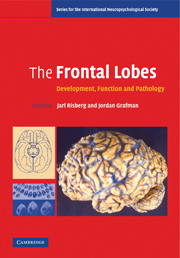Book contents
- Frontmatter
- Contents
- Contributors
- From the series editor
- Introduction
- 1 Evolutionary aspects on the frontal lobes
- 2 Organization of the principal pathways of prefrontal lateral, medial, and orbitofrontal cortices in primates and implications for their collaborative interaction in executive functions
- 3 Human prefrontal cortex: processes and representations
- 4 A microcircuit model of prefrontal functions: ying and yang of reverberatory neurodynamics in cognition
- 5 Prefrontal cortex: typical and atypical development
- 6 Case studies of focal prefrontal lesions in man
- 7 Left prefrontal function and semantic organization during encoding and retrieval in healthy and psychiatric populations
- 8 Clinical symptoms and neuropathology in organic dementing disorders affecting the frontal lobes
- Index
- Plate section
Introduction
Published online by Cambridge University Press: 11 September 2009
- Frontmatter
- Contents
- Contributors
- From the series editor
- Introduction
- 1 Evolutionary aspects on the frontal lobes
- 2 Organization of the principal pathways of prefrontal lateral, medial, and orbitofrontal cortices in primates and implications for their collaborative interaction in executive functions
- 3 Human prefrontal cortex: processes and representations
- 4 A microcircuit model of prefrontal functions: ying and yang of reverberatory neurodynamics in cognition
- 5 Prefrontal cortex: typical and atypical development
- 6 Case studies of focal prefrontal lesions in man
- 7 Left prefrontal function and semantic organization during encoding and retrieval in healthy and psychiatric populations
- 8 Clinical symptoms and neuropathology in organic dementing disorders affecting the frontal lobes
- Index
- Plate section
Summary
The frontal lobes are crucial to understanding our identity as autonomous beings and this significance is now reflected in the number and importance of neuropsychological, biological, and philosophical papers and books on the functions of the frontal lobes published over the last 40 years. This research effort has identified many of the functional properties of the frontal lobes but there are still numerous unsolved problems and controversies regarding its evolutionary, biological and functional status. Based on the theme of the International Neuropsychological Society's (INS) Summer Institute, this volume reviews this fascinating area of study. The Director of the Vivian Smith Advanced Studies Institute of the INS, Professor Andrew Papanicolaou, presents the background of the Institute in his foreword to this volume. He is also the editor of this new series of INS books starting with the present volume.
As the editors of this first book in the series, we are very proud to introduce you to the contents of the volume with the admittedly broad title The Frontal Lobes: Development, Function, and Pathology. While our volume does not cover every detailed aspect of this theme, we hope that the eight chapters will offer everyone interested in the frontal lobes an overview and some new and intriguing insights. The book is intended for graduate students in psychology and neuropsychology, as well as postdoctoral fellows and faculty members in departments of psychology, psychiatry, neurology, and related fields.
- Type
- Chapter
- Information
- The Frontal LobesDevelopment, Function and Pathology, pp. xi - xivPublisher: Cambridge University PressPrint publication year: 2006

